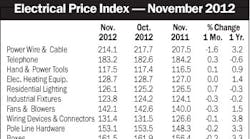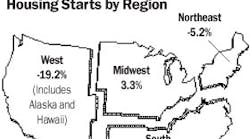Latest from Mag
People - Dec 21, 2012
Obituaries - Dec 21, 2012
November EPI Index Shows No Change
Housing Starts Dip 4% in November
Electrical Marketing - December 21, 2012
Around the Industry - Dec 21, 2012
While its larger neighbor to the south tends to hog many of North America’s economic headlines, Canada’s economy is making news these days, too. The Canadian dollar (affectionately called the “loonie” by Canadians and money traders) reached parity with the U.S. dollar in September 2007, the first time it had been on equal footing with the greenback since 1976. For Canadian citizens, this makes U.S. goods less expensive than at any time in recent memory. And in the current energy climate, Canada is also enjoying an economic bounty from its plentiful energy resources.
Nowhere in Canada is this newfound prosperity more apparent than the province of Alberta. According to Statistics Canada, Alberta’s economy grew by a nation-leading rate of 6.8 percent in 2006. Located about 1,700 road miles northwest of Chicago, Alberta’s economy has always been fueled by deposits of natural gas and oil. Alberta produces about 81 percent of Canada’s natural gas and 68 percent of its crude oil. Manufacturing shipments of energy-related products (petrochemicals and refined petroleum products) reached $28.4 billion in 2006. Said a report by Global Insight, Canadian Provincial Forecast and Analysis, “In 2008, Alberta is expected to take another step toward a more sustainable pace of growth, but still be comfortably above the Canadian average. Global Insight sees the Alberta economy growing more rapidly than Canada overall right through the medium term.”
The latest craze has been Alberta’s oil sands. It’s said that hidden beneath these oil sands is 300 billion barrels of oil and that only Saudi Arabia has more. While extracting oil from oil sands can be expensive, when the price of oil tops $100 a barrel, it’s worth the hassle.
“Where the price of oil is at right now, it makes it feasible for companies to invest money to extract this oil from the sand,” said Servando Cedillo, global product manager, Global Automation and Electrical Products Division, Molex Inc., Lincolnshire, Ill.
The capital of the oil sands frenzy is a frontier town called Fort McMurray, which lies on the 56th parallel north. The town’s population has doubled since 2000 to nearly 70,000 people, with projections for 100,000 by 2010, according to an article in the Feb. 25/March 3 issue of Engineering News-Record.
“The oil boom started in 2003 when oil approached $40 a barrel,” said Frank Dunnigan, president of Techspan Industries Inc., an Ontario-based manufacturer of electrical connector products. “In 2005, Alberta produced 760,000 barrels a day, and 1.1 million barrels a day in 2006. The oil sands were the source of 62 percent of Alberta’s total oil production and 47 percent of all oil produced in Canada. The Alberta government believes this level of production could reach 3 million barrels a day by 2020 and possibly 5 million barrels a day by 2030.”
But while the oil sands are drawing excitement, Ed Tuggle, D.A.D. Sales, a manufacturers’ rep, Disbury, Alberta, said it’s important to look at the whole economic picture. “Much of the Alberta economy is based on natural gas, and that is not doing very good right now. Many factors are contributing to a slowdown in Alberta’s economy — rising costs, lack of labor, the rising dollar, global economy, etc. It changes every six months, and it’s not as robust as what some might say it is.”
John W. Kerr Jr., chief executive officer, Kerrwil Publications, Toronto, Ontario, said conventional oil and gas drilling will slow down in 2008, but that the oil sands will continue to be driven hard. “Weakening natural gas prices, high costs and the impact of higher planned provincial royalties are pushing major firms to scale back exploration plans for 2008, from the already low levels seen in 2007,” said Kerr. Estimates show 14,500 wells to be drilled in western Canada in 2008, down from 18,500 in 2007 and 23,000 in 2006, he says.
The two largest markets in Alberta are Calgary in the south and Edmonton, about 190 miles to the north. “Calgary is the commercial center where the head offices of the oil companies reside. Therefore, residential and commercial electrical products are in heavier demand,” said Techspan Industries’ Dunnigan. “Edmonton is closer to the tar sands area and leans more heavily on industrial electrical equipment.”
Half of Alberta’s oil production uses standard drilling procedures with normal rigs, while the tar sands extractions are large-scale custom engineering jobs,” said Dunnigan. “The demand for electrical equipment is enormously widespread,” he said. “The oil boom has caused an enormous influx of workers from all over Canada. This has put a strain on the building industry. People have to live somewhere. Therefore, there has been demand for every type of electrical product. Heavy industrial equipment, such as explosion-proof products and electrical panel products, have been in great demand along with all other types of industrial electrical items. For the related building boom, all kinds of residential and commercial electrical equipment has been in demand as well.”
Alberta represents $1.6 billion in electrical sales, up from $1 billion only four years ago, according to the Pathfinder report, a Canadian economic report published by IP Group International. “In fact, for the first time in Canadian electrical history, the west, including British Columbia and Alberta, outspent Ontario on electrical equipment,” said Kerr, a senior executive with IP Group International, in addition to his post at Kerrwil.
The strong oil and gas business has caused other areas of the economy to thrive, too. While Lutron Electronics Co., Coopersburg, Pa., does not serve the industrial market, Rick Angel, senior vice president, says the commercial and residential markets in Alberta are strong. “From our perspective, it’s robust,” he says. “The market is very, very good. The commercial market’s strong, the outlook is strong, and the residential markets still appear to be strong for us as well,” he says. Because of the more industrial nature of Edmonton, Lutron does more business in Calgary than it does in Edmonton, says Angel.
Industry observers believe the boom will likely continue as long as the price of oil remains high. Based on what he has seen in sources such as The Wall Street Journal, Esposito from Molex says the price of oil is expected to remain high, between $90 a barrel and $125 a barrel, for about the next three years. “Shale extraction and oil extraction are kind of expensive,” he says. “As long as the price of oil stays around $100 a barrel, it’s going to be feasible for at least the next two to four years.”
Dunnigan of Techspan Industries also believes the boom is likely to continue as long as the price of oil remains high. “However, there is one looming factor,” he said. “Oil sands extraction emits a huge volume of carbon dioxide. With the world focusing on greenhouse emissions, there is pressure to slow down the growth of tar sands projects. Scientists are busy working on a process to capture greenhouse gases and store them underground, but this technology may not be implemented for years to come. There appears to be a careful balancing act coming up. How the U.S. and Canada balance strategic oil supply with the environment will be the major issue over the next few years and will definitely impact on production.”

